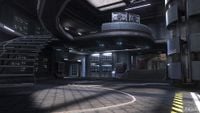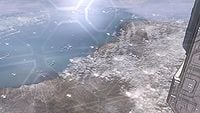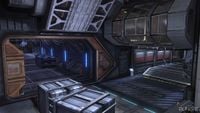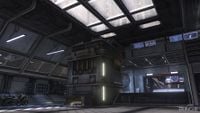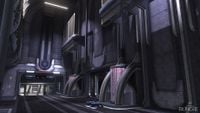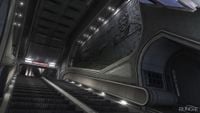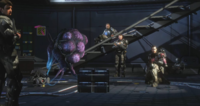Quito Space Tether: Difference between revisions
From Halopedia, the Halo wiki
m (→top: clean up, replaced: {{Article Quote → {{Article quote) |
m (Text replacement - "<references/>" to "{{Ref/Sources}}") |
||
| Line 45: | Line 45: | ||
==Sources== | ==Sources== | ||
{{Ref/Sources}} | |||
{{SpaceElevators}} | {{SpaceElevators}} | ||
[[Category:Earth]] | [[Category:Earth]] | ||
Revision as of 00:28, April 15, 2021
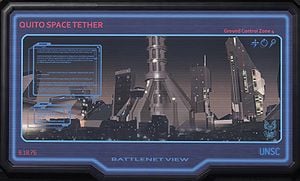
| “ | One of the finest examples of Civil Engineering which has shaped the development of society's quality of life in the 24th Century. | ” |
The Quito Space Tether is a space elevator located in Quito, Earth. As such, it is the second known space elevator in Latin America and one of six elevators on Earth.
Overview
It is used for lifting heavy ordnance from the surrounding port facilities into an orbital station at the top of the elevator structure, a transport method much cheaper and more efficient than booster rockets filled with expensive fuel.[1] As a space elevator would preferably have to be constructed near the equator,[2] Quito is an ideal location for such a structure as the city is located only a few kilometers south of the equator.[3]
Built by the International Society of Civil Engineers, the tether was completed on January 14, 2313[4] and named on March 9, 2401. The receiving station at the top of the elevator tether houses a monument dedicated to doctors Tobias Fleming Shaw and Wallace Fujikawa, the creators of the Shaw-Fujikawa Translight Engine.[5]
The orbital station on top of the tether had at least four gates leading to terminals from which passengers or cargo could be ferried to other UNSC-controlled worlds. During 2552, transports led to remaining UNSC worlds such as Gilgamesh and Ballast, and one to other planets in the Sol System. One flight, to Charybdis IX, had been indefinitely delayed, due to the planet's loss 17 years earlier.
Following the Battle of Mombasa in October, 2552, the station's Crimson's Wing was commandeered by ONI to safeguard and interrogate the Huragok, Quick to Adjust, as well as other aliens, over a period of weeks.[6][7][8]
The Quito Space Tether was among the four that survived the Battle of Earth.[9]
Trivia
- The Halo 3 multiplayer level Orbital takes place on the station on top of the Quito Space Tether.
- The elevator takes after the design of the Halo 2 version of the New Mombasa Orbital Elevator, where it is located in the middle of the city, compared to the Halo 3: ODST version where it is separate from the city and located on an artificial island.
Gallery
A plaque dedicated to the men and women who built the Space Tether, from the International Society of Civil Engineers.
The plaque devoted to Wallace Fujikawa.
The plaque devoted to Tobias Fleming Shaw.
Alpha-Nine stationed on the Quito Terminus in November, 2552.
List of appearances
- Halo 3 (First appearance)
- Halo 3: ODST
- Halo: New Blood
Sources
- ^ Game Informer: December 2008, page 8
- ^ Wikipedia - Space elevator
- ^ Wikipedia - Quito
- ^ Twitter.com: Today in Halo - 1/14/14
- ^ Halo 3, multiplayer map, Orbital
- ^ Halo: New Blood
- ^ Halo 3: ODST, Epilogue
- ^ Halo Legendary Crate, Data Drop #2
- ^ Halo Waypoint, Space Elevator article
|
| |||||

